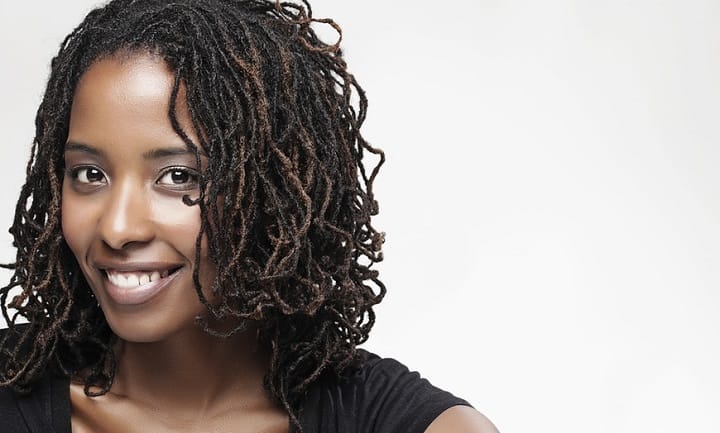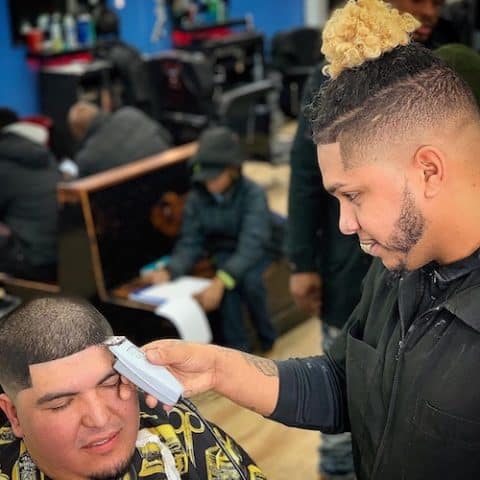You finally made that decision to cross into dreadlocks territory.
Everyone is wearing them, they seem cool, so why not try them?
What if I told you there is a simpler, easier, and waaaay cheaper way of creating dreadlocks?
Introducing – freeform dreads!
With freeform dreads there is no added stress of having to retwist them, layering some products or separating your roots.
Simply let your hair do its own thing and eventually you will get some luscious locks that will be the envy of many.
Instead of going for a very complicated wick dread hairstyle try some freeform dreads.
And here is how things go.
Our article will provide you with tips and information better than the ones found on YouTube videos or a blog.
Table Of Contents
Types of Freeform Dreadlocks
Freeform dreads are everything that their name implies. These types of dreads can create on their own without any specific manipulation.
Unlike crochet hairstyles what you need to do here is to section your hair a bit with a two-strand twist or braid and allow it to grow and develop on its own.
What you also need to keep in mind when creating freeform dreads is that you can’t have styles that make tension around the hairline or put pressure on the roots of the hair. Styling is out of the question with freeform dreads, making them a coveted hairstyle to rock.
There are alternative styles, like semi-freeform dreads, where something like a ponytail or a bun can be added.
But you can’t combine something like peekaboo braids with freeform dreads.
The development of your locks when creating freeform dreads is a bit unpredictable.
It is a type of hairstyle that does not allow much control, but it comes out beautifully as you take advantage of naturally curly hairstyles.
The hair will seem more natural as added manipulation is thrown out the window.
4 Most Popular Freeform Dreadlock Hairstyles
Even though the very idea of freeform dreads is not doing any extra manipulation or styling, there are a few ways that you can make them unique and set them apart from each other. You can consider the following four styles to emphasize these types of dreads.
Each method comes with its process and can create a unique curl pattern and loc styles, which depend on hair textures and hair types.
Layered Freeform Dreads
Once you get your freeform dreads going and they grow to the desired length, you can style them a little bit as you please.
One of them is the layered look which you can create with the help of some hairpins.
It is nothing too drastic but comes out exceptionally well, adding an intriguing dimension to the dreadlocks.
Pulled in a Bun
Another way to style freeform dreads is to tuck them away in a bun. However, the case here is that you will probably be dealing with a lot of hair, so the bun does not have to be perfect.
Allow strands of your hair to whisp out or tie a part of it into a bun while letting the rest fall to the side of your head or back.
Long and Flowing Freeform Dreads
The idea of creating freeform dreads is rooted in getting some natural hair.
There is no better way to allow your hair to look as natural as possible than by allowing it to grow long and will enable it to flow wherever it may. The only way to separate yourself from others is to put them on one side and make them even more effective.
Some people also like to use different hair color, but it is better to go to a top hair stylist or experts to get help.
Half Up Freeform Dreads
The idea behind wearing your hair half up is to show your face and not only get it out of the way.
Freeform dreads are unique and if you put them up in a bun or tie them up while allowing the rest to fall to your back or shoulders is a great option. You don’t need any highlights in black hair, as your natural hair will do everything for you that needs to be done.
How to Style and Maintain Freeform Dreads
Now that you are a hundred percent sure that freeform dreads are what you want leave aside short hairstyles for black women and prepare to grow and style them. It takes time and patience to do things right, but you will be doing something like this.
Step 1 – Section your hair
Start by washing your hair and then sectioning it into locs in a specific size that you want them to be in.
Single-out smaller sections will get thinner locks, while bigger sections mean thicker ones.
This part also depends on the thickness of your hair. Place a section of your hair over a part in the row below, similarly to creating layers, which will result in a fuller look.
Step 2 – Use the two-strand twist technique to braid the hair
Start using the two-strand twist technique to braid the hair. This should be done without any products, allowing your hair to form faster.
Some products may penetrate your hair and make it softer, at the same time hampering the flow and the formation of locs.
If some products get trapped inside the dreadlocks and they form, you may start to experience discoloration at some point.
Step 3 – Allow your hair to do its thing
The hair will grow on its own and start to develop freeform dreads. If you want to wash it regularly, you need to be sure that the locs are tied tightly, so they don’t break up on you when washing the hair.
Washing does help to make the hair to become tighter, but if you use too much conditioner or shampoos that soften your hair it will start to break up. It is also essential to thoroughly dry your locks after washing them, as damp locks will not be good for your hair.
Step 4 – Maintain
The maintenance of your locs basically includes washing them about once or twice a week.
The important part is to remove any possible buildup that could occur on your scalp.
We recommend washing with hot water and rinsing off with cold and you should do this for the first 12 months of hair growth.
How to Remove Freeform Dreads
The obvious way would be to cut them off, but since we want you to preserve your hair so you can transition to a different hairstyle like butterfly locs, there is a way of doing it without losing your hair.
The easiest way to do it is to come to the dreads out. However, this is not an easy task by all means.
You are going to need to get a good comb and some products that will soften your hair.
The next part involves being very patient and coming out as you apply the product that will let the dreads unravel.
You will need to do this with every separate dreadlock and it may take a long time to finish, depending on how thick your dreads are and how many of them you got.
After you comb all of it out, you will need to implement a hair care routine that will soften the hair and nourish it simultaneously.
Look for products with ingredients that are beneficial for your scalp and your hair.
FAQ
How long does it take to form freeform dreads?
The time needed to create freeform dreads depends on your hair type the hair care routine you implement and the starting length.
There are several methods that you can use to shape your hair and anyone has the freedom to try them.
How long do freeform dreads last?
They can last as long as you can maintain them. Using products that will provide the needed moisture to your hair and give it volume will help extend the life span of hair.
Can freeform dreads be undone?
Yes, they can. If you wash your hair with a shampoo or use a conditioner that will soften your hair the dreads will come undone.
Retwisting them and using some hair oils may also reduce the twists in your locs.
Can freeform dreads damage your hair?
Freeform dreads are less damaging to your hair than traditional dreads.
With freeform dreads you are allowing your hair to grow on its terms, while other techniques may result in hair dryness and breakage of hair.
The significance of hair products and conditioners used also needs to be taken into account as some provide benefits, but they can also damage the locs.
What is the difference between dreads and freeform dreads?
Freeform dreads are created in a manner where you don’t need to braid or manipulate them to get them.
On the other hand, traditional dreads require you to use a technique where you create them yourself.
You can learn how to do it by reading a guide to baddie hairstyles.
Jay is one of the members of the Beardoholic writers team and NFL, celebrity barber. As a master barber with years of experience, Jay can make your beard look any way you envision. Jay’s specialty is black men’s hair and beard styles, but he also has deep knowledge on how to create a perfect neck and cheek line, short or long beard and virtually any beard and hair shape and style.



